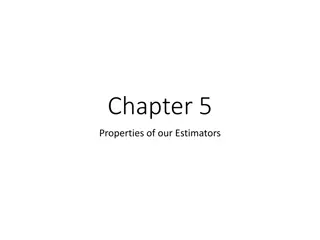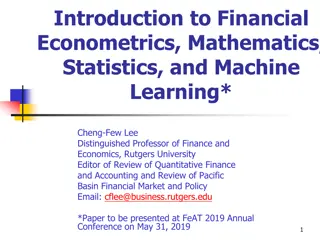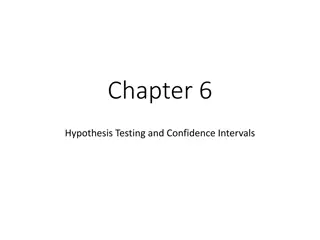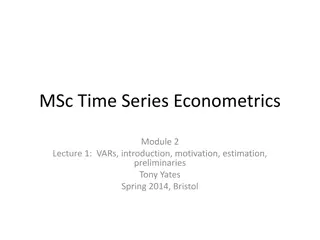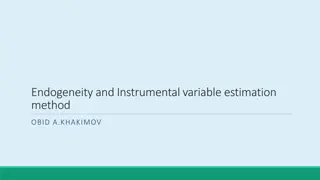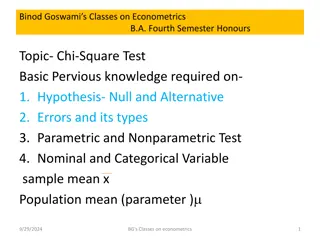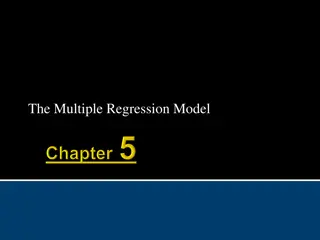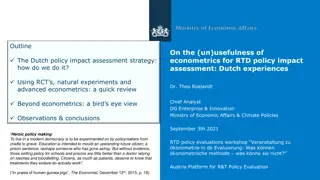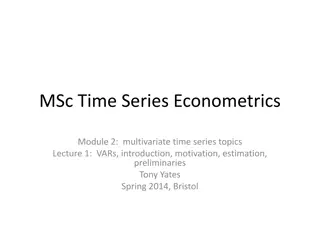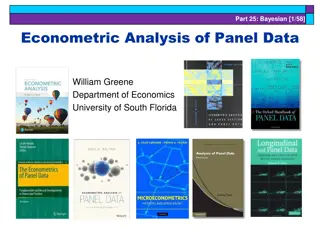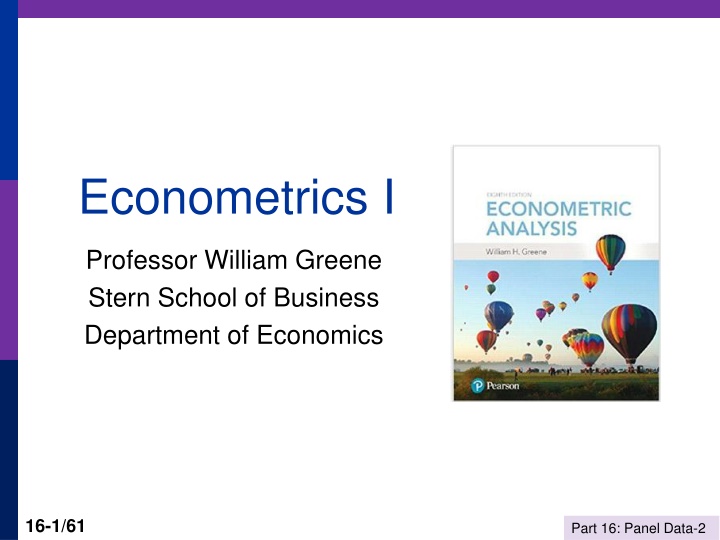
Understanding Panel Data Analysis in Econometrics
Explore the concepts of random effects model, error components model, convergence of moments, and the distinction between random vs. fixed effects in panel data analysis. Learn from Professor William Greene at the Stern School of Business, Department of Economics.
Download Presentation

Please find below an Image/Link to download the presentation.
The content on the website is provided AS IS for your information and personal use only. It may not be sold, licensed, or shared on other websites without obtaining consent from the author. If you encounter any issues during the download, it is possible that the publisher has removed the file from their server.
You are allowed to download the files provided on this website for personal or commercial use, subject to the condition that they are used lawfully. All files are the property of their respective owners.
The content on the website is provided AS IS for your information and personal use only. It may not be sold, licensed, or shared on other websites without obtaining consent from the author.
E N D
Presentation Transcript
Econometrics I Professor William Greene Stern School of Business Department of Economics 16-1/61 Part 16: Panel Data-2
Econometrics I Part 16 Panel Data-2 16-2/61 Part 16: Panel Data-2
The Random Effects Model The random effects model it +c + , observation for person i at time t +c + , T observations in group i + + , note (c ,c ,...,c ) + + , T observations in the sample c=( , ,... ) , c c i=1 y = = = y x X X c X c it i it y i i i i i i = c i i i i i i i N i=1 c = i 1 2 N iT by 1 vector N ci is uncorrelated with xit for all t; E[ci |Xi] = 0 E[ it|Xi,ci]=0 16-3/61 Part 16: Panel Data-2
Notation y y X X u u i i T observations T observations X u X w N i=1 1 1 1 1 1 1 2 2 2 2 2 2 = + + y X u i T observations N N N N N N = = In all that fo it and x contain a constant term as the first element. To avoid notational clutter, in those cases, x etc. will simply denote the counterpart without the constant term. Use of the symbol K for the number of variables will thus be context specific but will usually include the constant term. + + + T observations i llows, except where explicitly noted, X, X i it 16-4/61 Part 16: Panel Data-2
Error Components Model A Generalized Regression Model y + +u E[ | ] 0 E[ | ] E[u | ] 0 E[u | ] = + +u for T observations i y X i it = x b X X X X it it i 2 2 u 2 u 2 u 2 u + ... ... ... ... = = = = it 2 it i 2 u 2 2 u + ... = = Var[ +u ] i 2 i i i i 2 u 2 u 2 2 u + i 2 i i 2 u i i i i i 16-5/61 Part 16: Panel Data-2
Notation 2 2 u 2 u 2 u 2 u + 2 u 2 2 u + = Var[ +u ] i i i 2 u 2 u 2 2 u + 2 2 u + = I ii T T T i i i 2 2 u + = I ii T i = 0 i 0 0 0 1 (Note these differ only in the dimension T) 2 = Var[ w X | ] i 0 0 N 16-6/61 Part 16: Panel Data-2
Convergence of Moments i X X X X N i 1 i = = = f a weighted sum of individual moment matrices i N i 1 = X X T T X X i i N i 1 i = = = f a weighted sum of individual moment matrices i i N i 1 = T T X X i i i 2 N i 1 i = 2 N i 1 i = + = f f x x i u i i T i i i X X Note asymptoti cs are with respect to N. Each matrix is the i T i moments for the T observations. Should be 'well behaved' in micro level data. The average of N such matrices should be likewise. T or T is assum ed to be fixed (and small). i i 16-7/61 Part 16: Panel Data-2
Random vs. Fixed Effects Random Effects Small number of parameters Efficient estimation Objectionable orthogonality assumption (ci Xi) Fixed Effects Robust generally consistent Large number of parameters 16-8/61 Part 16: Panel Data-2
Ordinary Least Squares Standard results for OLS in a GR model Consistent Unbiased Inefficient True variance of the least squares estimator 1 1 -1 N 1 X X X X X X = Var[ | b X ] N N N T T T T = i 1 as N 0 = i 1 = i 1 = i 1 i i i i -1 0 Q Q* Q 16-9/61 Part 16: Panel Data-2
Estimating the Variance for OLS 1 1 N 1 X X X X X X = Var[ | b X ] N N N T T T T = i 1 = i 1 = i 1 = i 1 i i i i In the spirit of the White estimator, use f T T i i N X w w X T X X w N = = , = y - X b , f i i i = i 1 i i i i i N Hypothesis tests are then ba T i = i 1 = i 1 i i sed on Wald statistics. THIS IS THE 'CLUSTER' ESTIMATOR 16-10/61 Part 16: Panel Data-2
OLS Results for Cornwell and Rupert +----------------------------------------------------+ | Residuals Sum of squares = 522.2008 | | Standard error of e = .3544712 | | Fit R-squared = .4112099 | | Adjusted R-squared = .4100766 | +----------------------------------------------------+ +---------+--------------+----------------+--------+---------+----------+ |Variable | Coefficient | Standard Error |b/St.Er.|P[|Z|>z] | Mean of X| +---------+--------------+----------------+--------+---------+----------+ Constant 5.40159723 .04838934 111.628 .0000 EXP .04084968 .00218534 18.693 .0000 19.8537815 EXPSQ -.00068788 .480428D-04 -14.318 .0000 514.405042 OCC -.13830480 .01480107 -9.344 .0000 .51116447 SMSA .14856267 .01206772 12.311 .0000 .65378151 MS .06798358 .02074599 3.277 .0010 .81440576 FEM -.40020215 .02526118 -15.843 .0000 .11260504 UNION .09409925 .01253203 7.509 .0000 .36398559 ED .05812166 .00260039 22.351 .0000 12.8453782 16-11/61 Part 16: Panel Data-2
Alternative Variance Estimators +---------+--------------+----------------+--------+---------+ |Variable | Coefficient | Standard Error |b/St.Er.|P[|Z|>z] | +---------+--------------+----------------+--------+---------+ Constant 5.40159723 .04838934 111.628 .0000 EXP .04084968 .00218534 18.693 .0000 EXPSQ -.00068788 .480428D-04 -14.318 .0000 OCC -.13830480 .01480107 -9.344 .0000 SMSA .14856267 .01206772 12.311 .0000 MS .06798358 .02074599 3.277 .0010 FEM -.40020215 .02526118 -15.843 .0000 UNION .09409925 .01253203 7.509 .0000 ED .05812166 .00260039 22.351 .0000 Robust Cluster___________________________________________ Constant 5.40159723 .10156038 53.186 .0000 EXP .04084968 .00432272 9.450 .0000 EXPSQ -.00068788 .983981D-04 -6.991 .0000 OCC -.13830480 .02772631 -4.988 .0000 SMSA .14856267 .02423668 6.130 .0000 MS .06798358 .04382220 1.551 .1208 FEM -.40020215 .04961926 -8.065 .0000 UNION .09409925 .02422669 3.884 .0001 ED .05812166 .00555697 10.459 .0000 16-12/61 Part 16: Panel Data-2
Generalized Least Squares =[ =[ -1 1 -1 X X X X ] [ X y ] i i N i 1 = -1 i 1 N i 1 = -1 i ] [ X y ] i i 2 1 -1 i = I ii T 2 2 2 u + T i i (note, depends on i only through T) i 16-13/61 Part 16: Panel Data-2
Generalized Least Squares GLS is equivalent to OLS regression of y * y y . on = = + = x * x x ., it it i i it it i i where 1 i 2 2 u T i -1 -1 2 -1 = = Asy.Var[ ] [ X X ] [ X * X* ] 16-14/61 Part 16: Panel Data-2
Estimators for the Variances + + it i u Using the OLS estimator of , b it = y x it , OLS it T t 1 N 2 (y - - x b a ) i 2 2 U + estimates = i 1 = it T -1-K ( ) N = i 1 i With the LSDV estimates, a and LSDV b , i it T t 1 N 2 (y - - x b a ) i 2 estimates = i 1 = it T -N-K i ( ) N = i 1 i Using the difference of the two, it it T t 1 T t 1 N 2 N 2 (y - - x b a ) (y - - x b a ) i i 2 U estimates = i 1 = = i 1 = it T -1-K it T -N-K i ( ) ( ) N N = i 1 = i 1 i i 16-15/61 Part 16: Panel Data-2
Practical Problems with FGLS 2 u A bulletproof solution The preceding regularly produce negative estimates of Estimation is made very complicated in unbalanced panels. . it T t 1 N 2 (y a x LSDV b ) i 2 = From the robust LSDV estimator: = i 1 = it i T N = i 1 i it T t 1 N 2 (y a x b ) i 2 2 u 2 + = From the pooled OLS estimator: Est( ) = i 1 = it OLS T OLS N = i 1 i it it T t 1 T t 1 N 2 N 2 T (y a x b ) (y a x b ) i i 2 = u 0 = i 1 = = i 1 = it OLS OLS it i LSDV N = i 1 i 16-16/61 Part 16: Panel Data-2
Stata Variance Estimators it iT t 1 N 2 (y a x b ) 2 = > 0 based on FE estimates = i 1 = it i LSDV N T K N = i 1 i 2 (N (N K) A)T SSE(group means) N 2 = u Max 0, 0 A 2 u where A = K or if A=trace of a matrix that somewhat rese Many other adjustments exist. None guaranteed to be positive. No optimality properties or even guaranteed consistency. is negative, mbles I . K 16-17/61 Part 16: Panel Data-2
Other Variance Estimators i 1 N 2 N K (y a xb ) 2 2 u + = From the group means regression: / T = i 1 it MEANS T 1 t 1 N T s t 1 K w w N i i 2 u 2 = = u (Wooldridge) Based on E[w w | X ] if t s, = i 1 = = + it N is it is i T = i 1 i There are many others. Generally i these will also. x does not contain a constant term in the preceding. f the original, standard choices fail, 16-18/61 Part 16: Panel Data-2
Fixed Effects Estimates ---------------------------------------------------------------------- Least Squares with Group Dummy Variables.......... LHS=LWAGE Mean = 6.67635 Residuals Sum of squares = 82.34912 Standard error of e = .15205 These 2 variables have no within group variation. FEM ED F.E. estimates are based on a generalized inverse. --------+------------------------------------------------------------- Variable| Coefficient Standard Error b/St.Er. P[|Z|>z] Mean of X --------+------------------------------------------------------------- EXP| .11346*** .00247 45.982 .0000 19.8538 EXPSQ| -.00042*** .544864D-04 -7.789 .0000 514.405 OCC| -.02106 .01373 -1.534 .1251 .51116 SMSA| -.04209** .01934 -2.177 .0295 .65378 MS| -.02915 .01897 -1.536 .1245 .81441 FEM| .000 ......(Fixed Parameter)....... UNION| .03413** .01491 2.290 .0220 .36399 ED| .000 ......(Fixed Parameter)....... --------+------------------------------------------------------------- 16-19/61 Part 16: Panel Data-2
Computing Variance Estimators Using the full list of variables (FEM and ED are time invariant) OLS sum of squares = 522.2008. 2 2 u Using full list of variables and a generalized inverse (same as d ropping FEM and ED), LSDV sum of squares = 82.34912. + = 522.2008 / (4165 - 9) = 0.12565. 2 = 82.34912 / (4165 - 8-595) = 0.023119. 2 = u 0.12565 - 0.023119 = 0.10253 2 u Both estimators are positive. We stop here. If negative, we would use estimators without DF corrections. were 16-20/61 Part 16: Panel Data-2
Application ---------------------------------------------------------------------- Random Effects Model: v(i,t) = e(i,t) + u(i) Estimates: Var[e] = .023119 Var[u] = .102531 Corr[v(i,t),v(i,s)] = .816006 Lagrange Multiplier Test vs. Model (3) =3713.07 ( 1 degrees of freedom, prob. value = .000000) (High values of LM favor FEM/REM over CR model) Fixed vs. Random Effects (Hausman) = .00 (Cannot be computed) ( 8 degrees of freedom, prob. value = 1.000000) (High (low) values of H favor F.E.(R.E.) model) Sum of Squares 1411.241136 R-squared -.591198 +---------+--------------+----------------+--------+---------+----------+ |Variable | Coefficient | Standard Error |b/St.Er.|P[|Z|>z] | Mean of X| +---------+--------------+----------------+--------+---------+----------+ EXP .08819204 .00224823 39.227 .0000 19.8537815 EXPSQ -.00076604 .496074D-04 -15.442 .0000 514.405042 OCC -.04243576 .01298466 -3.268 .0011 .51116447 SMSA -.03404260 .01620508 -2.101 .0357 .65378151 MS -.06708159 .01794516 -3.738 .0002 .81440576 FEM -.34346104 .04536453 -7.571 .0000 .11260504 UNION .05752770 .01350031 4.261 .0000 .36398559 ED .11028379 .00510008 21.624 .0000 12.8453782 Constant 4.01913257 .07724830 52.029 .0000 16-21/61 Part 16: Panel Data-2
Testing for Effects: An LM Test Breusch and Pagan Lagrange Multiplier statistic 2 u 0 0 0 0 = + + y x u , u and ~ Normal , it it i it i it 2 2 = u H : General 0 0 2 N 2 N 2 ( T) (T e ) 2 LM = 1 [1] = i 1 T (T = i 1 i i i N N T t 1 2 it 2 1) e = i 1 = i 1 = i i Balanced Panel 2 i N 2 i ee [(Te ) ee ] NT = LM = i 1 i i N 2(T-1) = i 1 i 16-22/61 Part 16: Panel Data-2
Application: Cornwell-Rupert 16-23/61 Part 16: Panel Data-2
Testing for Effects Regress; lhs=lwage;rhs=fixedx,varyingx;res=e$ Matrix ; tebar=7*gxbr(e,person)$ Calc ; list;lm=595*7/(2*(7-1))* (tebar'tebar/sumsqdev - 1)^2$ LM = 3797.06757 16-24/61 Part 16: Panel Data-2
A Hausman Test for FE vs. RE Estimator Random Effects E[ci|Xi] = 0 Consistent and Efficient Fixed Effects E[ci|Xi] 0 Inconsistent FGLS (Random Effects) LSDV (Fixed Effects) Consistent Inefficient Consistent Possibly Efficient 16-25/61 Part 16: Panel Data-2
Computing the Hausman Statistic 1 1 T i 2 N i 1 = = Est.Var[ ] X I ii X FE i i -1 2 u T T i 2 N i 1 = = = Est.Var[ ] X I ii X , 0 1 i i RE i i 2 2 u + T i i 2 2 u ] Est.Var[ As long as will be nonnegative definite. In a finite sample, to ensure this, both must be computed using the same estimate of generally be the better choice. and are consistent, as N , Est.Var[ ] F E RE 2 . The one based on LSDV will Note invariant variables in . that columns of zeros will appear in Est.Var[ X ] if there are time FE does not contain the constant term in the preceding. 16-26/61 Part 16: Panel Data-2
Hausman Test +--------------------------------------------------+ | Random Effects Model: v(i,t) = e(i,t) + u(i) | | Estimates: Var[e] = .235368D-01 | | Var[u] = .110254D+00 | | Corr[v(i,t),v(i,s)] = .824078 | | Lagrange Multiplier Test vs. Model (3) = 3797.07 | | ( 1 df, prob value = .000000) | | (High values of LM favor FEM/REM over CR model.) | | Fixed vs. Random Effects (Hausman) = 2632.34 | | ( 4 df, prob value = .000000) | | (High (low) values of H favor FEM (REM).) | +--------------------------------------------------+ 16-27/61 Part 16: Panel Data-2
Fixed Effects +----------------------------------------------------+ | Panel:Groups Empty 0, Valid data 595 | | Smallest 7, Largest 7 | | Average group size 7.00 | | There are 2 vars. with no within group variation. | | ED FEM | Look for huge standard errors and fixed parameters.| | F.E. results are based on a generalized inverse. | | They will be highly erratic. (Problematic model.) | | Unable to compute std.errors for dummy var. coeffs.| +----------------------------------------------------+ +--------+--------------+----------------+--------+--------+----------+ |Variable| Coefficient | Standard Error |b/St.Er.|P[|Z|>z]| Mean of X| +--------+--------------+----------------+--------+--------+----------+ |WKS | .00083 .00060003 1.381 .1672 46.811525| |OCC | -.02157 .01379216 -1.564 .1178 .5111645| |IND | .01888 .01545450 1.221 .2219 .3954382| |SOUTH | .00039 .03429053 .011 .9909 .2902761| |SMSA | -.04451** .01939659 -2.295 .0217 .6537815| |UNION | .03274** .01493217 2.192 .0283 .3639856| |EXP | .11327*** .00247221 45.819 .0000 19.853782| |EXPSQ | -.00042*** .546283D-04 -7.664 .0000 514.40504| |ED | .000 ......(Fixed Parameter)....... | |FEM | .000 ......(Fixed Parameter)....... | +--------+------------------------------------------------------------+ | 16-28/61 Part 16: Panel Data-2
Random Effects +--------------------------------------------------+ | Random Effects Model: v(i,t) = e(i,t) + u(i) | | Estimates: Var[e] = .235368D-01 | | Var[u] = .110254D+00 | | Corr[v(i,t),v(i,s)] = .824078 | | Lagrange Multiplier Test vs. Model (3) = 3797.07 | | ( 1 df, prob value = .000000) | | (High values of LM favor FEM/REM over CR model.) | +--------------------------------------------------+ +--------+--------------+----------------+--------+--------+----------+ |Variable| Coefficient | Standard Error |b/St.Er.|P[|Z|>z]| Mean of X| +--------+--------------+----------------+--------+--------+----------+ |WKS | .00094 .00059308 1.586 .1128 46.811525| |OCC | -.04367*** .01299206 -3.361 .0008 .5111645| |IND | .00271 .01373256 .197 .8434 .3954382| |SOUTH | -.00664 .02246416 -.295 .7677 .2902761| |SMSA | -.03117* .01615455 -1.930 .0536 .6537815| |UNION | .05802*** .01349982 4.298 .0000 .3639856| |EXP | .08744*** .00224705 38.913 .0000 19.853782| |EXPSQ | -.00076*** .495876D-04 -15.411 .0000 514.40504| |ED | .10724*** .00511463 20.967 .0000 12.845378| |FEM | -.24786*** .04283536 -5.786 .0000 .1126050| |Constant| 3.97756*** .08178139 48.637 .0000 | +--------+------------------------------------------------------------+ 16-29/61 Part 16: Panel Data-2
The Hausman Test, by Hand --> matrix; br=b(1:8) ; vr=varb(1:8,1:8)$ --> matrix ; db = bf - br ; dv = vf - vr $ --> matrix ; list ; h =db'<dv>db$ Matrix H has 1 rows and 1 columns. 1 +-------------- 1| 2523.64910 --> calc;list;ctb(.95,8)$ +------------------------------------+ | Listed Calculator Results | +------------------------------------+ Result = 15.507313 16-30/61 Part 16: Panel Data-2
Hello, professor greene. I ve taken the liberty of attaching some LIMDEP output in order to ask your view on whether my Hausman test stat is large, requiring the FEM, or not, allowing me to use the (much better for my research) REM. Specifically, my test statistic, corrected for heteroscedasticity, is about 34 and significant with 6 df. I considered this a large value until I found your assignment 2 on the internet which shows a value of 2554 with 4 df. Now, I d like to assert that 34/6 is a small value. 16-31/61 Part 16: Panel Data-2
Variable Addition A Fixed Effects Model y LSDV estimator - Deviations from group means: To estimate , regress (y Algebraic equivalent: OLS regress y on ( = + + x it i it it x x y ) on ( ) x ,x it i it i ) it it i = + + + + + x Mundlak interpretation: Model becomes y = a random effects model with the group means. Estimate by FGLS. u i i i = + + + + x + x x x u it i i it it u i it it i = 16-32/61 Part 16: Panel Data-2
A Variable Addition Test Asymptotic equivalent to Hausman Also equivalent to Mundlak formulation In the random effects model, using FGLS Only applies to time varying variables Add expanded group means to the regression (i.e., observation i,t gets same group means for all t. Use Wald test to test for coefficients on means equal to 0. Large chi-squared weighs against random effects specification. 16-33/61 Part 16: Panel Data-2
Means Added to REM - Mundlak +--------+--------------+----------------+--------+--------+----------+ |Variable| Coefficient | Standard Error |b/St.Er.|P[|Z|>z]| Mean of X| +--------+--------------+----------------+--------+--------+----------+ |WKS | .00083 .00060070 1.380 .1677 46.811525| |OCC | -.02157 .01380769 -1.562 .1182 .5111645| |IND | .01888 .01547189 1.220 .2224 .3954382| |SOUTH | .00039 .03432914 .011 .9909 .2902761| |SMSA | -.04451** .01941842 -2.292 .0219 .6537815| |UNION | .03274** .01494898 2.190 .0285 .3639856| |EXP | .11327*** .00247500 45.768 .0000 19.853782| |EXPSQ | -.00042*** .546898D-04 -7.655 .0000 514.40504| |ED | .05199*** .00552893 9.404 .0000 12.845378| |FEM | -.41306*** .03732204 -11.067 .0000 .1126050| |WKSB | .00863** .00363907 2.371 .0177 46.811525| |OCCB | -.14656*** .03640885 -4.025 .0001 .5111645| |INDB | .04142 .02976363 1.392 .1640 .3954382| |SOUTHB | -.05551 .04297816 -1.292 .1965 .2902761| |SMSAB | .21607*** .03213205 6.724 .0000 .6537815| |UNIONB | .08152** .03266438 2.496 .0126 .3639856| |EXPB | -.08005*** .00533603 -15.002 .0000 19.853782| |EXPSQB | -.00017 .00011763 -1.416 .1567 514.40504| |Constant| 5.19036*** .20147201 25.762 .0000 | +--------+------------------------------------------------------------+ 16-34/61 Part 16: Panel Data-2
Wu (Variable Addition) Test --> matrix ; bm=b(12:19);vm=varb(12:19,12:19)$ --> matrix ; list ; wu = bm'<vm>bm $ Matrix WU has 1 rows and 1 columns. 1 +-------------- 1| 3004.38076 16-35/61 Part 16: Panel Data-2
LSDV is a Control Function Estimator = + = + = + = it it it i it Cov[ ,w ] Cov[ ,(c + )] is correlated with the FEs embedded in w . LS regression of on is inconsistent because is correlated with . We seek a control function (.) such that | (.) is uncorrelated with . (In the presence of (.), is not correlated with .) Using the Frisch-Waugh theorem =[ ] D D b X M X X M y ssion of y on [ , ]. I.e., add group means to the regression. y x x x x c + (c + ) w it it i it it i it it it = x g x ( ) 0 it x it it y X X w h X h w h X w 1 Consider regre X X 16-36/61 Part 16: Panel Data-2
LSDV is a Control Function Estimator Consider regression of y on [ , ]. I.e., add group means to the regression. x x x x x x X X X X x x .i .i x x .i .i x x i i 11 12 1K 11 1 12 1 11 1 21 22 2K 21 2 22 2 11 2 = [ , ] x x I M x x .i x .i x .i N1 X, ( - X P X X F N2 NK N1 N N2 N NK N = [ = [ , = [ , ] ) ] X D ] D 16-37/61 Part 16: Panel Data-2
LSDV is a Control Function Estimator Using the Frisch-Waugh theorem =[ b X M X 1 ] X M y ControlFunction X M X X I F F 1 = X I P X X P P X [ F F F ( ) F X X P X ] F 1 = P [ ( ) ] D D D D is symmetric and idempotent. And [ ( - ) ( ( - X I I M X X I M X P = - ] X I M D D ) D 1 = Multiply this out in full and collect some terms ) ) X I M ( - D D D ( )( ) 1 = The two large matrices cancel. One more step = - ( - ) = = . Likewise, X M X X M y = b b X IX - X I M X ( - ) X I M X ( - ) X I M X ( - ) D D D X X X I M X X X - X X + X M y X M X D D D = . Therefore, D F ControlFunction LSDV 16-38/61 Part 16: Panel Data-2
16-39/61 Part 16: Panel Data-2
A Hierarchical Linear Model Interpretation of the FE Model it = + y E[ | c E[u| ] y x x c + , ( does not contain a constant) ,c ] 0,Var[ | ,c ]= X X x it i it 2 = it z i + u , i it i i i z = + i i i i i 2 u = = 0, Var[u| ] u] z z i i i it i = + + [ + + it i it 16-40/61 Part 16: Panel Data-2
Hierarchical Linear Model as REM +--------------------------------------------------+ | Random Effects Model: v(i,t) = e(i,t) + u(i) | | Estimates: Var[e] = .235368D-01 | | Var[u] = .110254D+00 | | Corr[v(i,t),v(i,s)] = .824078 | | Sigma(u) = 0.3303 | +--------------------------------------------------+ +--------+--------------+----------------+--------+--------+----------+ |Variable| Coefficient | Standard Error |b/St.Er.|P[|Z|>z]| Mean of X| +--------+--------------+----------------+--------+--------+----------+ OCC | -.03908144 .01298962 -3.009 .0026 .51116447 SMSA | -.03881553 .01645862 -2.358 .0184 .65378151 MS | -.06557030 .01815465 -3.612 .0003 .81440576 EXP | .05737298 .00088467 64.852 .0000 19.8537815 FEM | -.34715010 .04681514 -7.415 .0000 .11260504 ED | .11120152 .00525209 21.173 .0000 12.8453782 Constant| 4.24669585 .07763394 54.702 .0000 16-41/61 Part 16: Panel Data-2
Evolution: Correlated Random Effects Unknown parameters y , [ , Standard estimation based on LS (dummy variables) Ambiguous definition of the distribution of y = + + = , , 2 x ,..., ] it i it it 1 2 N it Effects model, nonorthogonality, heterogeneit y , E[ Contrast to random effects E[ Standard estimation (still) based on LS (dummy variables) y = + + = x X X | ] g( |X ] ) = 0 it i it it i i i i i Correlated random effects, more detailed model y , P[ = + + x Linear projection? = = X x X | ] + g( ) 0 it i it it i i i = x u Cor(u , ) 0 i i i i i 16-42/61 Part 16: Panel Data-2
Mundlaks Estimator Mundlak, Y., On the Pooling of Time Series and Cross Section Data, Econometrica, 46, 1978, pp. 69-85. i i + Write c = x u , E[c | x , x ,... x ] = x i i i i1 i1 iT i Assume c contains all time invariant information = +c + , T observations in group i = + + + u Looks like random effects. Var[ + u ]= i + This is the model we used for the Wu test. i y X X ix i i i i i i i i i i i 2 u ii i i i 16-43/61 Part 16: Panel Data-2
Mundlaks Approach for an FE Model with Time Invariant Variables it i = + y E[ | c E[w| y random effe time varying variables. x z + c + , ( does not contain a constant) ,c ] 0,Var[ | ,c ]= + w , , ] 0, Var[w| , w x cts model including group means of x it i it 2 = X X it x i i it i i i X z z = + i i 2 w = = X z ] i i i i i i it i i = = + + + + + x it i it 16-44/61 Part 16: Panel Data-2
Mundlak Form of FE Model +--------+--------------+----------------+--------+--------+----------+ |Variable| Coefficient | Standard Error |b/St.Er.|P[|Z|>z]| Mean of X| +--------+--------------+----------------+--------+--------+----------+ x(i,t)================================================================= OCC | -.02021384 .01375165 -1.470 .1416 .51116447 SMSA | -.04250645 .01951727 -2.178 .0294 .65378151 MS | -.02946444 .01915264 -1.538 .1240 .81440576 EXP | .09665711 .00119262 81.046 .0000 19.8537815 z(i)=================================================================== FEM | -.34322129 .05725632 -5.994 .0000 .11260504 ED | .05099781 .00575551 8.861 .0000 12.8453782 Means of x(i,t) and constant=========================================== Constant| 5.72655261 .10300460 55.595 .0000 OCCB | -.10850252 .03635921 -2.984 .0028 .51116447 SMSAB | .22934020 .03282197 6.987 .0000 .65378151 MSB | .20453332 .05329948 3.837 .0001 .81440576 EXPB | -.08988632 .00165025 -54.468 .0000 19.8537815 Variance Estimates===================================================== Var[e]| .0235632 Var[u]| .0773825 16-45/61 Part 16: Panel Data-2
Panel Data Extensions Dynamic models: lagged effects of the dependent variable Endogenous RHS variables Cross country comparisons large T More general parameter heterogeneity not only the constant term Nonlinear models such as binary choice 16-46/61 Part 16: Panel Data-2
The Hausman and Taylor Model it x2 it z2 i i = + + + + + y Model: Deviations from group means removes all time invariant variables y y ( ) ( Implication: , 1 2 are consistently estimated by LSDV. ( ) = K instrumental variables i it x1 - x1 x2 - x2 z1 ? strumental variables (where do we get them?) x1 x2 z1 z2 u it 1 2 1 2 it i and are correlated with u. = + + x1 - x1 ' x2 - x2 ' ) i i it i it 1 it 2 it 1 ( ) = K instrumental variables = L instrumental variables (uncorrelated with u) = L in i it 2 i 1 2 H&T: x1 = K additional instrumental variables. Needs K L . i 1 1 2 16-47/61 Part 16: Panel Data-2
H&Ts 4 Step FGLS Estimator 2 (1) LSDV estimates of (2) ( ) IV regression of consistently estimates (3) With fixed T, resid , , 1 2 e* '= (e ,e ,...,e ),(e ,e ,...,e ),...,(e ,e ,...,e ) on with instruments and ual variance in (2) estimates 1 1 1 2 2 2 N N N e* Z * W . i 1 2 2 2 + u / T 2 2 + u With unbalanced panel, it estimates resembling this. (1) provided an estimate of to obtain estimates of (1/T) or something so use the two For each group, compute 2 2 u 2 and . 2 2 2 u ,x = i (4) Transform [ + 1 / ( T ) i x ,z ,z ] to it1 it2 i1 i2 W*= x [ ,x ,z ,z ] - [ x ,x ,z ,z ] i it1 it2 i1 i2 i i1 i2 i1 i2 and y to y * = y - y . it it it i i 16-48/61 Part 16: Panel Data-2
H&Ts 4 STEP IV Estimator = Instrumental Variables V i ( x1 - x1 ) = K instrumental variables i it 1 ( z1 x2 - x2 ) = K instrumental variables = L instrumental variables (uncorrelated with u) i it 2 i 1 = K additional in Now do 2SLS of all parameters. I.e., x1 strumental variables. with instruments to estimate i 1 y * on W * V W * W* W * y *. -1 [ , , , ]=( ) 1 2 1 2 16-49/61 Part 16: Panel Data-2
16-50/61 Part 16: Panel Data-2





